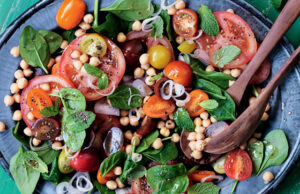THE MEDITERRANEAN DIET AND RISK OF TYPE 2 DIABETES

The Mediterranean diet (Med-diet) is a traditional pattern of eating that involves the habitual consumption of foods and drinks from the countries located in and around the Mediterranean Sea. It is characterized by high consumption of vegetables, fruits, olive oil, legumes, wholegrains, nuts, and seafood, moderate intake of dairy (especially fermented varieties like yoghurt and cheese) and wine, and a low consumption of red meat. Importantly, the Med-diet is recognized as a healthy dietary pattern with great palatability!
Research has found that higher consumption of whole grains and vegetables is associated with a lower risk of developing type 2 diabetes and, in contrast, higher consumption of red and processed meat is associated with an increased risk of developing type 2 diabetes. It is therefore logical to think that people that habitually consume a Med-diet will have a lower risk of developing type 2 diabetes.
A recent systematic review and meta-analysis investigated the association between people’s adherence to the Med-diet and the risk of developing type 2 diabetes in adults. It included 14 prospective cohort studies with 410,303 participants and 41,466 cases of type 2 diabetes, followed up over 3 ½ – 22 years. Six of the studies were carried out in Europe, six in the United States and two in Asia. One study was conducted only in men, two studies only in women and the other 11 studies were conducted in men and women. Therefore, overall, it would be fair to say that the results are applicable to a significant proportion of the population.
Comparing extreme categories of the Med-diet adherence score (those who adhered closely to the diet principles compared to those that did not follow the principles at all) indicated that highest compared to the lowest category of adherence to the Med-diet was associated with a 21% lower risk of developing type 2 diabetes. Furthermore, a dose–response meta-analysis indicated a linear inverse association between Med-diet adherence score and the risk of developing type 2 diabetes. In other words, the more a person adhered to the Med-diet principles, the lower their risk of developing type 2 diabetes. Finally, the significant inverse association remained stable in studies with long term follow-up (≥ 10 years), suggesting a beneficial long-term effect of the Med-diet in preventing type 2 diabetes.
There are many possible reasons why the Med-diet may decrease a person’s risk of developing type 2 diabetes. It increases the concentration of antioxidants, reduces levels of inflammatory markers and raises either plasma ferric reducing antioxidant potential or total radical-trapping antioxidant parameter. Greater adherence to the Med-diet can reduce body weight and therefore, can decrease levels of cardiometabolic risk factors that are traditionally accompanied by adiposity, like blood pressure and blood fats. The low glycemic load and fibre-rich nature of the Med-diet lead to increased satiety, contributing to a better metabolic profile and reduced total energy (kilojoules/Calories) intake. Finally, the higher ratio of unsaturated to saturated fatty acids, resulting from greater consumption of seafood and olive oil compared to red meat and poultry, may confer thermogenic properties.
Overall, the Med-diet is a healthy and enjoyable dietary pattern that may be useful in preventing type 2 diabetes.
Read more:
- Zeraattalab-Motlagh and colleagues. Mediterranean dietary pattern and the risk of type 2 diabetes: a systematic review and dose-response meta-analysis of prospective cohort studies. Eur J Nutr. 2022

Dr Alan Barclay, PhD, is a consultant dietitian and chef with a particular interest in carbohydrates and diabetes. He is author of Reversing Diabetes (Murdoch Books), and co-author of nearly 40 scientific publications, The Good Carbs Cookbook (Murdoch Books), Managing Type 2 Diabetes (Hachette Australia) and The Ultimate Guide to Sugars and Sweeteners (The Experiment Publishing).
Contact: Follow him on Twitter, LinkedIn or check out his website.







